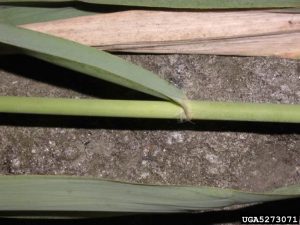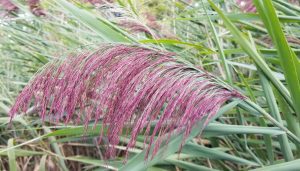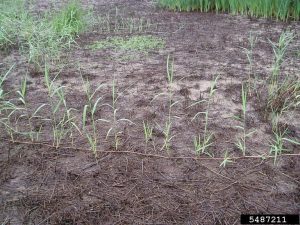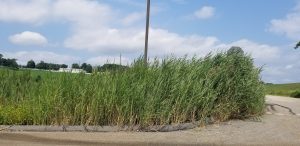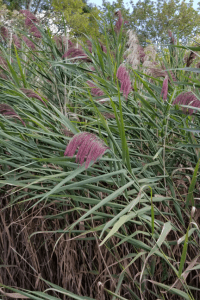Invasive Plant Factsheet Common reed (Phragmites australis)
Authors: Victoria Wallace, Alyssa Siegel-Miles, and Klaudia Sowizral
Victoria.Wallace@uconn.edu
Reviewer: Charlotte Pyle, Natural Resources Conservation Service (retired), and former CT Invasive Plant Working Group (CIPWG) co-chair
Publication # EXT071 | June 2024
Overview
Phragmites australis is an aggressive, robust perennial grass, which creates dense infestations. It is easily identified by its height (five to thirteen feet) and
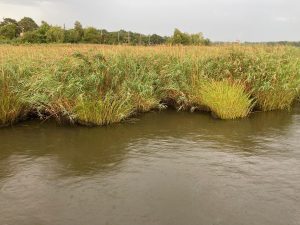
feathery flowers, which appear in June. The leaves range between one-half to two inches wide, and from six to eighteen inches long. They are blue green, lance-shaped, and alternate, and may be upright to arching. The leaf blades are smooth and may be either flat or rolled. Veins parallel. Midvein is white near the base of the leaf; inconspicuous towards tip. Leaf sheath is open, glabrous (smooth). Long, fine, white hairs present where leaf blades diverge from the reedy stem.
Phragmites creates dense monocultures in freshwater marshes and wetlands, as well as along river edges and roadsides. It is common to brackish (slightly saline) environments and disturbed sites. Its salt tolerance allows it to persist where
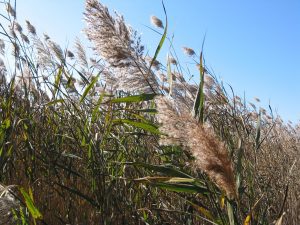
few other species can survive. Phragmites prefers full sun, but can withstand partial shade. It invades and degrades vast areas of important wetland habitat, threatening the wildlife that depend on those areas for survival. Invasive Phragmites was introduced to North America in the late 1700s-early 1800s. Common reed is found throughout the U.S., particularly in the northern Midwest, the Northeast, and on the West coast.
Native Phragmites species may form dense stands, but lack the aggressive characteristics of the European strain. Native common reed leaves are lighter (compared to P. australis) and yellowish-green. Its stems are smooth, shiny, red-brown to dark red-brown, and the leaf sheaths are more likely to be shed in winter. There is no evidence of hybridization between native and non-native Phragmites.
Other identifying features of Phragmites australis include:
- STEMS: Hollow, smooth; 6-12 ft tall. Tan or green, often red at the base, with smooth nodes and hollow internodes. Aerial stems borne from rhizome joints can take root and produce new shoots.
- FLOWERS/INFLORESCENCES: Densely branched, erect or drooping, fluffy, purple, 6-16 in long terminal flower spikes appear in June (Figure 1). Inflorescence matures to gray and persists through winter. Lance-shaped inflorescence is composed of 3-11 spikelets. The rachilla (stem between the florets) is covered with long silky hairs.
- SEEDS: Light-weight, brown, 8 mm long; form in August and disperse through January. Will not germinate in salinity greater than 2%, or when deeper than 2 in. in soil.
- ROOTS: Extensive root networks often exceed 20 ft in length; form a dense, interwoven mass that grows 3-30 ft per year (growth is greater in nutrient–rich locations).
- REPRODUCTION/SPREAD: Mainly vegetative, via an extensive system of rhizomes (underground stems), which generate new plants up to 43 ft from the parent plant. Can also spread by wind-blown or bird-deposited seed, although seed set is highly variable and germination rates are typically low. Maintenance equipment (e.g., mowers) can be a source of spread of both vegetative rhizome fragments or seed.
Control
A combination of remediation tactics, including thorough monitoring and ongoing treatment, are necessary to manage invasive common reed. New York Invasive Species Information states that management should be “site-specific, goal-specific, and value-driven,” due to different variables found at each site. Native and non-native Phragmites appear similar, so correct identification is critical before taking management action.
A suitable restoration plan is necessary before Phragmites removal is initiated. Timely replanting with native species adapted to site conditions is important for habitat protection, as elimination of Phragmites colonies may increase erosion.
PREVENTION: Plant or protect native species that can limit the spread of Phragmites. Jesuit’s bark (Iva frutescens), groundsel-tree (Baccharis halimifolia), black rush (Juncus roemerianus), and saltmeadow cordgrass (Spartina patens) can successfully compete with Phragmites. Ensure that proper sanitary practices are in place to prevent creating new populations of Phragmites via contaminated maintenance equipment (e.g. mowers).
MECHANICAL: Hand pulling is not feasible due to common reed’s extensive rhizomes and root system. Mowing may be an appropriate component of a management plan, although it usually is required to be done in combination with chemical controls for long-term success. For best eradication results, plants should be cut annually just before the end of July, to maximize stress on the plant at its weakest point in the growing season. Remove any rhizome fragments, which can start new plants. Cutting common reed at the incorrect time of the year may increase stand density.
HYDROLOGIC: Manipulating the water level around Phragmites has been shown to decrease populations in some conditions. Refer to the Element Stewardship Abstract produced by the Nature Conservancy for more information.
CONTROLLED BURNING: Common reed can withstand burning - the top growth is killed but roots and rhizomes are not. Prescribed burns, in conjunction with chemical treatments, may be effective when performed the year following a chemical treatment, ideally in July-August or in the winter, prior to spring green up. Learn more at invasive.org or fs.fed.us.
CHEMICAL: Follow label instructions for all applications. Refer to CIPWG Management Calendar (cipwg.uconn.edu).
- Foliar: Systemic herbicides (e.g., glyphosate, Imazapyr - specified for wetland use when management is being performed in or near water bodies), may be applied to foliage from June to September, when plants are actively growing (late summer, after flowering, is recommended). Follow up treatments should be repeated annually, in August- September, after plants have sufficiently regrown from previous treatments.
- Cut-stem treatments are suitable for small infestations and can be performed from mid-summer to fall. Cut individual stems below the lowest leaf and apply a systemic herbicide (appropriate for aquatic use if applying in or near water) to the stem and around the cut edge.
Additional Resources
Breen, D. B., Bailey, S. D., Violi, H. A. (2014). Managing Remnant and Reemerging Common Reed (Phragmites australis) Infestations to Improve Treatment Efficacy and Mitigate Damage to Native Plants. Invasive Plant Science and Management, 7(3), 445-453. https://doi.org/10.1614/IPSM-D-14-00009.1
Connecticut Invasive Plant Working Group. (n.d.). Phragmites, Common Reed (Phragmites australis). https://cipwg.uconn.edu/phragmites/
Cornell Cooperative Extension, Putnam County. (Updated 2020, May 8). Common Reed. https://albany.cce.cornell.edu/environment/invasive-plants/common-reed
Missouri Department Of Conservation. (n.d.). Common Reed. https://mdc.mo.gov/discover-nature/field-guide/common-reed
National Park Service & U.S. Fish and Wildlife Service. (2010). Grasses & Sedges: Control options. In Plant Invaders of Mid-Atlantic Natural Areas, 4th ed. https://www.invasive.org/alien/ pubs/midatlantic/control-grassesandsedges.htm
Sturtevant, R., Fusaro, A., Conard, W., Lott, S., Wishahm, L. & Van Zeghbroeck, J. (Updated 2023, August 30). Phragmites australis australis (Cav.) Trin. ex Steud. U.S. Geological Survey, Nonindigenous Aquatic Species Database & NOAA Great Lakes Aquatic Nonindigenous Species Information System. https://nas.er.usgs.gov/queries/greatlakes/FactSheet.aspx?Species_ID=2937
United States Department of Agriculture, Natural Resources Conservation Service. (n.d.). Phragmites Adans. Retrieved April 2021 from https://plants.usda.gov/home/plantProfile? symbol=PHRAG
University of Maine Cooperative Extension (n.d.). Common Reed Fact Sheet. https://extension.umaine.edu/signs-of-the-seasons/indicator-species/common-reed-fact-sheet/
The information in this document is for educational purposes only. The recommendations contained are based on the best available knowledge at the time of publication. Any reference to commercial products, trade or brand names is for information only, and no endorsement or approval is intended. UConn Extension does not guarantee or warrant the standard of any product referenced or imply approval of the product to the exclusion of others which also may be available. The University of Connecticut, UConn Extension, College of Agriculture, Health and Natural Resources is an equal opportunity program provider and employer
